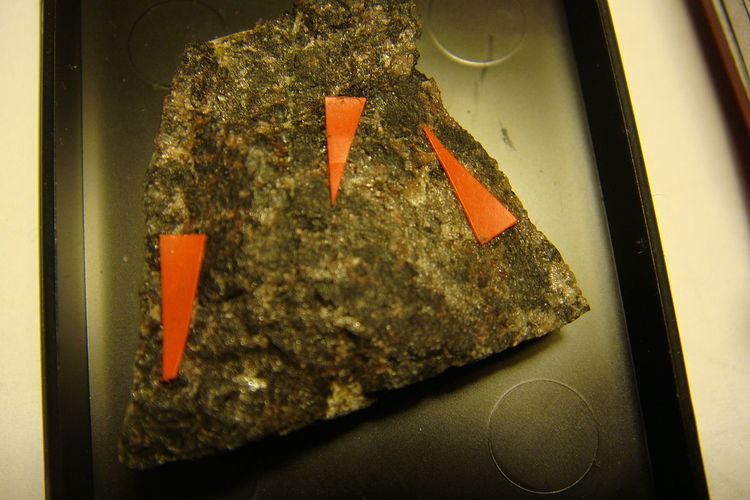Category Silicate mineral Crystal system Monoclinic Formula mass 551.04 g/mol | Formula(repeating unit) CaCeMg2AlSi3O11F(OH) Space group P21/m | |
 | ||
Crystal class Prismatic (2/m)(same H-M symbol) | ||
Dollaseite-(Ce) is a sorosilicate end-member epidote mineral and was discovered by Gajer (1927) in the Ostanmossa mine, Norberg district, Sweden, the mineral wrongly named “magnesium orthite” after Gajer (1927) himself was renamed after the structure refinement made to the mineral by Peacor and Dunn (1988) led to the proper classification. The name dollaseite-(Ce) was chosen in honor of Professor Wayne Dollase, who performed broad research on the epidote-group minerals. The original confusion of the mineral’s composition was because of a complex atomic composition where an exchange of cations leads to a form of dollaseite-(Ce) that at first glimpse resembles an Mg analogue of allanite, now known as dissakisite-(Ce). Dollaseite-(Ce), although not very well known is part of a broad group of minerals, the epidote group which are primarily silicates, the most abundant type of minerals on earth. Dollaseite-(Ce) forms as dark-brown subhedral crystals primarily in Sweden mines. With the ideal chemical formula, CaREE3+Mg2AlSi3O11,(OH)F, dollaseite-(Ce) can be partially identified by its rare content of the REE (rare earth element) Ce.
Contents
Composition
With a general formula for the epidote group of A2M3Si3O13H dollaseite-(Ce) receives its formula of CaREE3+Mg2AlSi3O11,(OH)F based on data from electron-microprobe analytical procedures. The results give the empirical formula (Ca.91 Ce.45 La.20 Nd.20 Pr.09 Sm.08 Gd.06)(Mg1.81 Fe.25)Al.97 Si3.0(OH)1.25 F.88 O10.99 from which the standard formula is then derived after applying Levinson’s rules for renaming REE minerals. Before any of these highly technological analyses were performed on dollaseite-(Ce) specimens, mistakes were made on the composition of the mineral. After further analysis were made it was determined that dollaseite-(Ce) was not the Magnesium (Mg) analogue of allanite as originally believed by Gaijer (1927) and was renamed. Geijer (1927) however, was not the only one to have had reported minerals with compositions that would be similar to an Mg analogue of allanite. Enami and Zang’s (1988), Meyer (1911), Hanson and Pearce (1941) also reported minerals that resembled the composition of an Mg analogue of allanite but none had sufficient data, or exact composition to be declared as an Mg analogue of allanite. It was not until 1991 that Edward S. Grew established dissakisite as the actual Mg dominant allanite mineral with formula Ca(Ce,La)MgAl2Si3O12(OH).
Structure
The atomic structure of dollaseite-(Ce) can be somewhat complex at times due to the charge-coupled substitution involving both cations and anions: (Fe, Al)3+ + O2– = Mg2+ + F–. The original confusion of the composition of this mineral when it was first discovered can be due to this exchange of cations and anions, an exchange which is not always complete and thus can resemble dissakisite-(Ce), the Mg dominant allanite. The average epidote-group mineral’s structure has chains of edge-sharing octahedral such as Al, Fe3+, Mn3+ which are represented in Figure 1. The cavities that are formed by the octahedral chains that are occupied by A(1) and A(2) cations are occupied by Ca and its REE, Ce3+. Like the rest of the members of the epidote group, the aluminum octahedral in dollaseite-(Ce) share edges, forming endless chains.
Physical properties
Similar to the other epidote-group minerals, dollaseite-(Ce) is monoclinic and thus is part of the space group P 2 1/M. Peacor and Dunn (1988) refined the lattice parameters of dollaseite-(Ce) and concluded that the parameters were a=8.934(18) Å, b=5.721(7)Å, c=10.176(22)Å. Dollaseite-(Ce) can generally be found in mineralized dolomite-tremolite rocks in the form of dark brown and subhedral crystals
Geologic occurrence
Dollaseite-(Ce) can occur in a number of locations, but the most prominent is at Ostanmossa, Sweden. The type of dollaseite-(Ce) that can generally be found at this location tends to be Fe-poor and occurs in tremolite skarn. The fact that dollaseite-(Ce) can be prominently found in Sweden comes as no surprise since Sweden has been known to host many REE epidote-group minerals such as dissakisite-(Ce) and allanite-(Ce). Another dollaseite-(Ce) specimen with composition slightly similar to that of dissakisite-(Ce) can be found in rock composed of fluorite and fluorian phlogopite.
